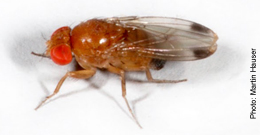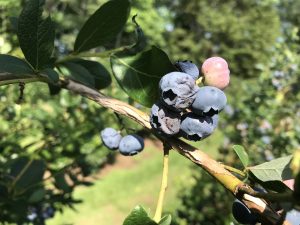Spotted Wing Drosophila Alert and Berry Notes — July 21, 2023
David Handley, Vegetable and Small Fruit Specialist; James Dill, Pest Management Specialist, Phil Fanning, Assistant Professor of Agricultural Entomology, Christina Howard, Maine New Farmer Project Manager

Spotted Wing Drosophila:
Numbers of spotted wing drosophila fruit flies caught in traps that we have set up in raspberry and blueberry fields in Maine have seen moderate increases at several sites over the past week. Fly counts this week were mostly at low levels, but traps in Wells, Bowdoinham, New Gloucester and Sanford captured numbers considered potentially damaging to ripening berry crops, especially raspberries and blueberries. When 6 to 10 flies are caught in a yeast-baited trap in a week, larvae will start appearing in the fruit. This week counts have been ranging from 0 to 120 in our traps, indicating that ripening fruit should be protected to prevent infestation.
Populations are likely to continue building in the coming weeks as more food (ripe fruit) becomes available for the flies, especially if conditions remain warm and wet as predicted. Now is the time to set out your own traps if you haven’t already. Start protective sprays on any berries that have begun to ripen when more than four spotted wing drosophila flies are caught in a trap, or any larvae are noticed in the fruit. Look for fruit flies hovering around fruit and symptoms of premature fruit decay. At this point, a one to two week schedule of sprays should be adequate to minimize fruit infestation, but as populations continue to build, a 5-7 day spray schedule may be required.

For more information on identifying spotted wing drosophila (SWD) and updates on populations around the state, visit our Spotted Wing Drosophila Blog.
Berry Notes:
- Japanese beetles are in very high numbers at many farms around the state, infesting raspberries, blueberries and grapes. In addition to feeding on foliage and fruit, they are a nuisance to pickers and often end up in the picking containers. Several of same products for controlling spotted wing drosophila will also provide control of Japanese beetles including Mustang Maxx® and Brigade®.
- Cranberry Fruitworm was found in a blueberry planting this week. This small (1/2”) green caterpillar resides within fruit clusters, tying 3-6 berries together with silk and feeding within those fruit, filling them with brown frass. The fruitworms will often be observed crawling out of picking containers when the infested fruit cluster is harvested. Insecticide sprays for cranberry fruitworm should be applied at petal fall, so plan on applications next spring if the planting was infested this year.
-

Anthracnose on blueberries; photo by Dr. David Handley Anthracnose fruit rot was observed in several blueberry fields this week. The weather has been very conducive for this fungus. Infected berries soften and collapse. Small orange dots will develop on the fruit surface, which are the spores. These will be spread onto healthy fruit through rain splashing and dripping. Pristine®, Switch® and Captan® offer good control of anthracnose.
Other IPM Web Pages
Michigan State University Spotted Wing Drosophila
Penn State University Spotted Wing Drosophila Overview
University of New Hampshire SWD Weekly IPM Reports
David T. Handley
Vegetable and Small Fruit Specialist
Highmoor Farm
P.O. Box 179
Monmouth, ME 04259
207.933.2100
Pest Management Office
491 College Avenue
Orono, ME 04473
1.800.287.0279
Where brand names or company names are used it is for the reader’s information. No endorsement is implied nor is any discrimination intended against other products with similar ingredients. Always consult product labels for rates, application instructions and safety precautions. Users of these products assume all associated risks.
The University of Maine is an equal opportunity/affirmative action institution.
| Town | Spotted Wing Drosophila weekly trap catch 7/21/23 |
|---|---|
| Wells | 7 |
| Sanford | 7 |
| Limington | 3 |
| New Gloucester | 120 |
| Mechanic Falls | 0 |
| Bowdoinham | 15 |
| Monmouth | 1 |
